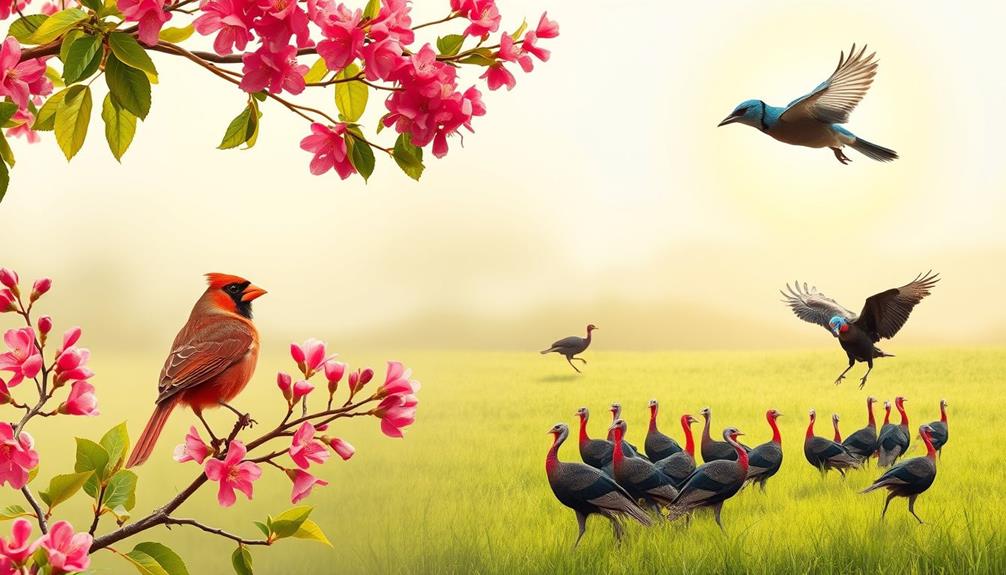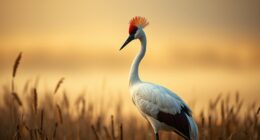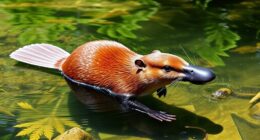Animals find water in the wild using their senses and behaviors. They smell moisture from miles away, spot reflective surfaces, and even hear flowing water. Certain species track established trails and environmental cues, while others adapt to seasonal changes in water availability. Many animals also need moisture from food, seeking out juicy fruits and plants during dry times. Curious about the specific techniques different animals use? There's much more to discover about their survival strategies!
Key Takeaways
- Animals use their keen sense of smell to detect water sources from great distances.
- Visual cues, like reflective surfaces, help birds and other animals locate water.
- Many species track established trails and lush vegetation indicative of nearby hydration.
- Seasonal migrations lead animals to regions with reliable water sources during dry spells.
- Animals extract moisture from food, relying on high-water-content fruits and plants for hydration.
The Role of Senses in Water Detection

When you think about how animals find water, it's fascinating to realize that they rely heavily on their senses. Many mammals and birds have an incredible sense of smell, allowing them to detect water sources from miles away.
Take elephants, for example; they can sense underground water through vibrations in the ground, making them experts at finding hidden sources during dry spells.
Birds, with their exceptional vision, spot reflective surfaces like ponds from the sky, guiding them directly to water.
Rodents use their acute hearing to hone in on the sound of flowing water, leading them to rivers.
Even desert dwellers like camels can detect moisture hidden beneath the surface or within vegetation, showcasing nature's ingenuity in survival.
Behavioral Indicators of Water Sources

When you're observing animals in their natural habitat, you'll notice how they use tracking patterns and seasonal migration routes to find water.
They often pick up on scent and sound cues, following the trail left by others.
These behaviors reveal just how instinctual and resourceful animals can be when searching for that essential resource.
Animal Tracking Patterns
To locate water sources, animals rely on a range of tracking patterns that reveal their behavioral indicators.
You can observe several key signs that show how they find hydration:
- Scent and Visual Cues: Animals often track the smell of wet soil or look for lush vegetation, which typically signals nearby water.
- Established Trails: Many species, like deer and birds, create distinct paths to water, indicating their regular routes for hydration.
- Activity Timing: Animals tend to be more active during dawn and dusk when temperatures are cooler, making it easier for them to seek water, especially in arid regions.
These behaviors highlight their instinctual knowledge of the environment, showcasing their adaptations for survival.
Seasonal Migration Routes
As animals navigate their environments, they often commence seasonal migrations that lead them to essential water sources, especially during dry spells.
Many species, like elephants and birds, instinctively shift their locations based on the availability of reliable hydration. You might notice behavioral indicators like changes in feeding patterns or increased movement toward specific areas, signaling their search for water.
For instance, wildebeest follow historical migratory routes tied to water availability, ensuring their survival during droughts. They rely on environmental cues, such as dense vegetation or the distant sounds of flowing water, to guide them.
Remarkably, these migratory paths are often repeated annually, reflecting learned behaviors passed down through generations in their quest for life-sustaining water.
Scent and Sound Cues
Animals possess remarkable abilities to detect water sources through their acute senses of smell and hearing. You might be surprised to learn how different species utilize these senses effectively:
- Smell: Many animals can sense moisture in the air from miles away, guiding them to hidden water sources.
- Sound: Birds, for example, rely on their keen hearing to locate flowing water, which can lead them to streams or rivers.
- Scent Trails: Animals like deer and bears follow scent trails left by others, picking up on the smell of wet soil or vegetation near water.
These behavioral indicators are crucial for survival, showcasing nature's intricate ways of finding essential resources like water.
Adaptations for Finding Underground Water

When searching for underground water, various animals showcase remarkable adaptations that enhance their survival in harsh environments.
Elephants and kangaroos, for example, use their exceptional sense of smell to detect underground water sources from several kilometers away.
Meanwhile, the fennec fox digs deep into the sand, showcasing its adaptability to arid conditions.
Desert-dwelling animals like the Arabian oryx have evolved to survive long periods without water, efficiently utilizing moisture from their food.
Insects, such as ants, follow chemical trails left by their peers to locate water sources, demonstrating teamwork in their quest.
Each of these adaptations highlights the incredible ways animals have evolved to find essential water supplies beneath the surface, ensuring their survival in challenging habitats.
Water Sourcing Techniques Among Birds

Survival in arid environments isn't just about finding underground water; birds have their own clever strategies for sourcing hydration. They use various techniques to find water, showcasing their adaptability.
Birds demonstrate remarkable adaptability in arid environments, employing clever strategies to source hydration beyond just finding water.
- Observational Skills: Birds often watch other animals, like mammals and insects, to locate nearby water sources. Their keen eyesight helps them identify potential hydration options.
- Sound Recognition: Some species, like the American robin, listen for flowing water or rustling leaves, guiding them to hidden ponds or streams.
- Moisture Extraction: Many birds use their beaks to extract moisture from fruits and plants, allowing them to stay hydrated without direct access to water sources.
These strategies help birds thrive, even in the driest conditions.
Moisture Acquisition From Food Sources

When you think about how animals stay hydrated, consider the moisture they get from their food.
Many creatures, from herbivores munching on juicy fruits and veggies to carnivores feasting on their prey, rely heavily on the water content in what they eat.
Even insects tap into this resource, absorbing moisture from their organic meals to stay hydrated.
Fruits and Vegetables
Many animals actively seek out fruits and vegetables not just for their nourishment but also for the essential moisture they provide. In arid environments, hydration from food becomes critical.
For example, animals like elephants and monkeys rely on these sources to stay hydrated.
You'll find that:
- Fruits like cucumbers and watermelons can contain up to 90% water, making them essential hydration sources.
- Herbivores target succulent plants during dry seasons due to their moisture retention, ensuring they get both water and food.
- Some species, like kangaroos and camels, thrive by deriving hydration from the plants they consume, allowing them to go longer without direct water access.
Insects and Grains
Insects have a remarkable ability to extract moisture from their food sources, making grains and decaying organic matter essential for their hydration. Many insects, like ants and beetles, thrive on grains such as corn and wheat, which contain about 10-15% moisture. This allows them to hydrate indirectly. For instance, the desert locust can survive long periods without direct water by metabolizing moisture from its food.
Here's a glimpse of some common food sources and their moisture content:
| Food Source | Moisture Content | Insect Example |
|---|---|---|
| Corn | 10-15% | Ants |
| Wheat | 10-15% | Beetles |
| Fungi | High | Honeybees |
| Decaying Matter | Variable | Various Insects |
Animal Prey Moisture
While insects efficiently extract moisture from grains and organic matter, larger animals also rely on their food sources for hydration. Many animals adapt their diets to meet their moisture needs, ensuring survival in various environments.
Here are some key examples:
- Rodents and Reptiles: They often consume fruits and plants that can contain over 90% water, providing essential hydration.
- Carnivores: Lions and wolves derive significant moisture from the blood and tissues of their prey, reducing their need for external water sources.
- Herbivores: Deer and elephants eat succulent vegetation, especially during dry seasons, to access crucial moisture when water is scarce.
This diverse range of moisture acquisition methods helps animals thrive in challenging conditions.
Seasonal Changes and Water Availability

As seasonal changes unfold, water availability fluctuates dramatically, compelling animals to adapt their foraging strategies.
During extended dry spells, many natural water sources dry up, forcing you to travel longer distances in search of hydration.
In winter, snow and ice become your primary water source, which you can melt by consuming or using body heat.
Spring brings melting snow and increased rainfall, creating temporary puddles and streams that quench your thirst.
In summer, as vegetation flourishes, you might rely on dew and juicy fruits for additional moisture when larger bodies of water are scarce.
If you're a migratory bird, you'll likely adjust your migration patterns, seeking out regions abundant in water for breeding and feeding.
The Impact of Habitat on Water Accessibility

Habitat loss from urbanization and climate change profoundly impacts how animals access water.
With fewer natural water sources available, wildlife often turns to human-provided options for survival. This shift forces animals to adapt their foraging behavior and travel long distances to locate water.
Here are three key effects of habitat on water accessibility:
- Reduced Natural Sources: As habitats shrink, fewer streams and ponds remain, directly affecting animal populations.
- Behavioral Changes: Animals learn to identify cues like specific plants or sounds to find water, showcasing their adaptability.
- Increased Competition: In arid areas, prolonged droughts lead to fierce competition, raising mortality rates among species reliant on limited water sources.
Maintaining accessible water is essential for supporting biodiversity and healthy ecosystems.
Frequently Asked Questions
How to Find a Water Source in the Wild?
To find a water source in the wild, start by looking for signs of wildlife activity, like tracks or droppings.
Follow the land's natural slope, since water flows downhill. Pay attention to vegetation; lush areas typically indicate nearby moisture.
Listen for flowing water or birds, as they often gather close to water.
In dry regions, check for wet soil or specific plants that hint at underground water sources.
Stay observant!
Can Animals Detect Water?
Yes, animals can detect water using various methods. For instance, they often rely on their acute sense of smell to locate hidden sources, while some species sense vibrations in the ground to find underground water.
Birds use their exceptional eyesight to spot water bodies during migration. Additionally, certain mammals can even detect humidity in the air, guiding them to hydration sources in arid landscapes.
Their survival often depends on these remarkable abilities.
How Do Animals in the Desert Get Water?
In the desert, animals get water through various clever methods.
You might notice some, like kangaroo rats, rely on the moisture in their food, using metabolic water from digestion.
Others, such as camels, can drink large amounts at once, allowing them to endure long dry spells.
You'll also see foxes and coyotes digging for hidden water sources, while tortoises store water in their bodies, excreting very little to survive the harsh climate.
How Do Squirrels Find Water?
When you're curious about how squirrels find water, you'll discover they rely on various sources. They locate streams, ponds, and even puddles, but they also get moisture from fruits and nuts they eat.
During dry spells, they remember where those water sources are, returning to them as needed. Their keen sense of smell helps them sniff out water from a distance, making them adaptable even in urban environments.
Conclusion
In the grand tapestry of nature, animals showcase a remarkable knack for finding water, often with a touch of ingenuity that might surprise you. They rely on their senses, clever behaviors, and unique adaptations to uncover life's essential elixir, even in the most challenging conditions. As you observe these fascinating creatures, remember that their quest for water is a demonstration of their resilience and adaptability in a world where every drop counts. Embrace the wonder of their watery pursuits!










